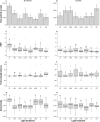Behavioural rhythms of two amphipod species Marinogammarus marinus and Gammarus pulex under increasing levels of light at night
- PMID: 40773521
- PMCID: PMC12331069
- DOI: 10.1371/journal.pone.0329449
Behavioural rhythms of two amphipod species Marinogammarus marinus and Gammarus pulex under increasing levels of light at night
Abstract
Artificial light at night (ALAN) is proliferating at an alarming rate across the globe, particularly around aquatic habitats. Natural and predictable light cycles dictate much of an individual organism's life by acting as a major signal for their circadian clock, driving rhythmic behaviours and physiological changes throughout the body. Light cycles also help populations coordinate group behaviour and greatly impact the interspecies dynamics of a community. Research into the ecological impacts of ALAN has highlighted numerous effects on these biological processes, including higher predation rates, impaired growth and development, and diminished reproductive success. Invertebrates play an undeniable role in ecosystem functioning and show robust daily rhythms. As such, it is vital to understand how ALAN may disrupt their behavioural patterns. The aim of this study was to monitor the impacts of increasing levels of light at night (0 lux - 80 lux), as well as constant light and constant darkness, on the behavioural rhythms of the intertidal amphipod, Marinogammarus marinus, and the freshwater species, Gammarus pulex. Gammarus pulex activity was not strongly synchronised to any of the light at night treatments. Marinogammarus marinus, however, exhibited strong behavioural rhythmicity in diurnal cycles with dark night periods. All the ALAN treatments resulted in a significant decrease in M. marinus rhythmicity and overall activity. Moreover, ALAN between 1-50 lux disrupted nocturnality in this species. These results indicate that while some amphipods show some adaptive plasticity when it comes to light pollution, others may experience strong direct impacts on their activity. This may be relevant to individual and population level fitness of vulnerable species in more heavily urbanised areas.
Copyright: © 2025 Underwood et al. This is an open access article distributed under the terms of the Creative Commons Attribution License, which permits unrestricted use, distribution, and reproduction in any medium, provided the original author and source are credited.
Conflict of interest statement
The authors have declared that no competing interests exist.
Figures


References
-
- Garstang RH. Night-sky brightness at observatories and sites. Publ Astron Soc Pac. 1989;101:306.
-
- Davies TW, Bennie J, Inger R, Gaston KJ. Artificial light alters natural regimes of night-time sky brightness. Sci Rep. 2013;3:1722.
MeSH terms
LinkOut - more resources
Full Text Sources
Research Materials

